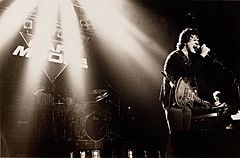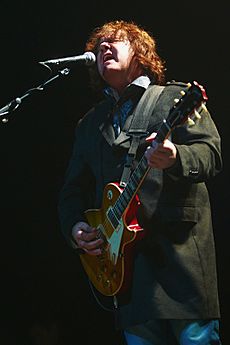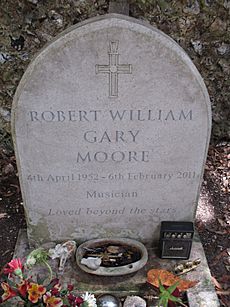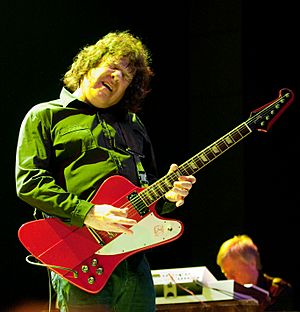Gary Moore facts for kids
Quick facts for kids
Gary Moore
|
|
|---|---|
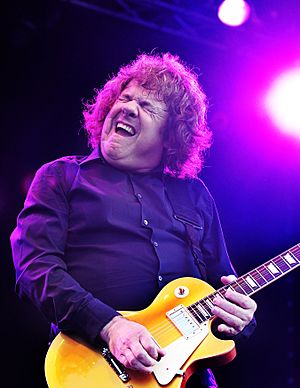
Moore performing in 2008
|
|
| Background information | |
| Birth name | Robert William Gary Moore |
| Born | 4 April 1952 Belfast, Northern Ireland |
| Died | 6 February 2011 (aged 58) Estepona, Spain |
| Genres | |
| Occupations | Musician, songwriter |
| Years active | 1968–2011 |
| Labels | MCA, Jet, Virgin, Sanctuary, Eagle |
Robert William Gary Moore (4 April 1952 – 6 February 2011) was a Northern Irish musician. Over the course of his career he played in various groups and performed a range of music including blues, blues rock, hard rock, heavy metal, and jazz fusion.
Influenced by Peter Green and Eric Clapton, Moore began his career in the late 1960s when he joined Skid Row, with whom he released two albums. After Moore left the group he joined Thin Lizzy, featuring his former Skid Row bandmate and frequent collaborator Phil Lynott. Moore began his solo career in the 1970s and achieved major success with 1978's "Parisienne Walkways", which is considered his signature song. During the 1980s, Moore transitioned into playing hard rock and heavy metal with varying degrees of international success. In 1990, he returned to his roots with Still Got the Blues, which became the most successful album of his career. Moore continued to release new music throughout his later career, collaborating with other artists from time to time. Moore died on 6 February 2011 from a heart attack while on holiday in Spain.
Moore was often described as a virtuoso and has been cited as an influence by many other guitar players. He was voted as one of the greatest guitarists of all time on respective lists by Total Guitar and Louder. Irish singer-songwriter Bob Geldof said that "without question, [Moore] was one of the great Irish bluesmen". For most of his career, Moore was heavily associated with Peter Green's famed 1959 Gibson Les Paul guitar. Later he was honoured by Gibson and Fender with several signature model guitars.
Contents
Early life
Robert William Gary Moore was born in Belfast on 4 April 1952, the son of Winnie, a housewife, and Robert Moore, a promoter who ran the Queen's Hall ballroom in Holywood. He grew up near Belfast's Stormont Estate with four siblings. He credited his father for getting him started in music. When Moore was six years old, his father invited him onstage to sing "Sugartime" with a showband at an event he had organised, which first sparked his interest in music. His father bought him his first guitar, a second-hand Framus acoustic, when Moore was 10 years old. Though left-handed, he learned to play the instrument right-handed. Not long after, he formed his first band, The Beat Boys, who mainly performed Beatles songs. He later joined Platform Three and The Method, amongst others. Around this time, he befriended guitarist Rory Gallagher, who often performed at the same venues as him. He left Belfast for Dublin in 1968 just as The Troubles were starting in Northern Ireland. A year later, his parents separated.
Career
Skid Row
After moving to Dublin, Moore joined Irish blues rock band Skid Row. At the time, the group were fronted by vocalist Phil Lynott. He and Moore soon became friends, and they shared a bedsit in Ballsbridge. However, after a medical leave of absence, Lynott was asked to leave Skid Row by the band's bassist Brush Shiels, who had taken over lead vocal duties. In 1970, Skid Row signed a recording contract with CBS, and released their debut album Skid, which reached number 30 on the UK Albums Chart. After the album 34 Hours in 1971, and tours supporting The Allman Brothers Band and Mountain amongst others, Moore decided to leave the band. Moore had become frustrated by Skid Row's "limitations", opting to start a solo career. In retrospect, Moore stated: "Skid Row was a laugh but I don't have really fond memories of it, because at the time I was very mixed up about what I was doing." Sebastian Bach, former frontman of the American heavy metal band Skid Row, claimed that Moore sold them the rights to the name in 1987 for a reported $35,000. Brush Shiels contested the story in 2012, claiming he still owns the rights. Rachel Bolan of the American Skid Row also refuted the story in 2019, stating: "There was never any money exchange. Snake and I went and trademarked the name, and there was no problem."
Thin Lizzy
After leaving Skid Row, Phil Lynott formed the hard rock group Thin Lizzy. After the departure of guitarist Eric Bell, Moore was recruited to help finish the band's ongoing tour in early 1974. During his time with the group, Moore recorded three songs with them, including "Still in Love with You", which he co-wrote. The song was later included on Thin Lizzy's fourth album Nightlife. Moore then left Thin Lizzy in April 1974. While he enjoyed his time in the band, Moore felt it wasn't good for him, stating: "After a few months I was doing myself in, drinking and high on the whole thing."
In 1977, Moore rejoined Thin Lizzy for a tour of the United States after guitarist Brian Robertson injured his hand in a bar fight. After finishing the tour, Lynott asked Moore to join the band on a permanent basis, but he declined. Brian Robertson eventually returned to the group, before leaving for good in 1978. Moore took his place once again, this time for long enough to record the album Black Rose: A Rock Legend, which was released in 1979. The record was a success, being certified gold in the UK. However, Moore abruptly left Thin Lizzy that July in the middle of another tour. Moore subsequently said he had no regrets about leaving the band, "but maybe it was wrong the way I did it. I could've done it differently, I suppose. But I just had to leave." Thin Lizzy would eventually disband in 1983 with Moore making guest appearances on the band's farewell tour. Some of the performances were released on the live album Life.
Following Lynott's death in January 1986, Moore performed with members of Thin Lizzy at the Self Aid concert the following May. He joined the stage with former Thin Lizzy members again in August 2005, when a bronze statue of Lynott was unveiled in Dublin. A recording of the concert was released as One Night in Dublin: A Tribute to Phil Lynott.
Solo career
In 1973, Moore released the album Grinding Stone, which was credited to The Gary Moore Band. An eclectic mix of blues, rock and jazz, the album proved to be a commercial flop with Moore still unsure of his musical direction. While still a member of Thin Lizzy, Moore released his first proper solo album Back on the Streets in 1978. It spawned the hit single "Parisienne Walkways", which also featured Phil Lynott on lead vocals and bass. The song reached number eight on the UK Singles Chart and is considered Moore's signature song. After leaving Thin Lizzy in 1979, Moore relocated to Los Angeles where he signed a new recording contract with Jet Records. He recorded the album Dirty Fingers, which was shelved in favour of the more "radio-oriented" G-Force album, which came out in 1980. Dirty Fingers was eventually released in Japan in 1983, followed by an international release the next year.
After moving to London and signing a new recording contract with Virgin, Moore released his second solo album Corridors of Power in 1982. While not a major success, it was the first album to feature Moore on lead vocals throughout, as well as his first solo release to crack the Billboard 200 chart. Musically Corridors of Power featured "more of a rock feel", with additional influences from AOR bands, such as Journey and REO Speedwagon. The album also featured former Deep Purple drummer Ian Paice, Whitesnake bassist Neil Murray, and keyboardist Tommy Eyre, who had previously played with Moore in Greg Lake's backing band. During the supporting tour for Corridors of Power, singer John Sloman was also hired to share lead vocal duties with Moore, while Eyre was replaced by Don Airey. In 1983, Moore released the album Victims of the Future, which marked another musical change, this time towards hard rock and heavy metal. The album also saw the addition of keyboardist Neil Carter, who would continue to push Moore in this new musical direction. For the supporting tour, they were joined by former Rainbow bassist Craig Gruber and drummer Bobby Chouinard, who were later replaced by Ozzy Osbourne bassist Bob Daisley and former Roxy Music drummer Paul Thompson, respectively.
In 1985, Moore released his fifth solo album Run for Cover, which featured guest vocals by Phil Lynott and Glenn Hughes. Moore and Lynott performed the hit single "Out in the Fields", which reached the top five in both Ireland and the UK. On the back of its success, Run for Cover achieved gold certification in Sweden, as well as silver in the UK. For the album's supporting tour, Paul Thompson was replaced by drummer Gary Ferguson. Glenn Hughes was supposed to join the band on bass, but he was replaced by Bob Daisley. Following Phil Lynott's death, Moore dedicated his sixth solo album, 1987's Wild Frontier, to him. A blend of Celtic folk music, blues and rock, the album proved to be another success, being certified platinum in Sweden, gold in Finland and Norway, as well as silver in the UK. The album also spawned the hit single "Over the Hills and Far Away", which charted in nine countries. For the accompanying tour, former Black Sabbath drummer Eric Singer joined Moore's backing band. Wild Frontier was followed up by 1989's After the War, which featured drummer Cozy Powell. However, he was replaced by Chris Slade for the supporting tour. While After the War achieved gold status in Germany and Sweden, as well as silver in the UK, Moore had grown tired of his own music.
In 1990, Moore released the album Still Got the Blues, which saw him returning to his blues roots and collaborating with the likes of Albert King, Albert Collins and George Harrison. The idea for the record had come up during the supporting tour for After the War – Moore would often play the blues by himself in the dressing room when one night Bob Daisley jokingly suggested that he do a whole blues album. This change in musical style was also underlined by a change in Moore's wardrobe. He now sported a smart blue suit for videos and live performances instead of being "all dolled up like some guy in Def Leppard". This was a conscious decision by Moore to attract new listeners and inform his old audience that "this was something new". In the end, Still Got the Blues proved to be the most successful album of Moore's career, selling over three million copies worldwide. The album's title track also became the only single of Moore's solo career to chart on the Billboard Hot 100, where it reached number 97 in February 1991. For the album's supporting tour, Moore assembled a new backing band, dubbed The Midnight Blues Band, featuring Andy Pyle, Graham Walker, Don Airey, as well as a horn section.
Still Got the Blues was followed up by 1992's After Hours, which went platinum in Sweden and gold in the UK. The record also became Moore's highest charting album in the UK where it reached number four. In 1995, Moore released Blues for Greeny, a tribute album to his friend and mentor Peter Green. After experimenting with electronic music on Dark Days in Paradise (1997) and A Different Beat (1999), Moore once again returned to his blues roots with 2001's Back to the Blues. This was followed-up by Power of the Blues (2004), Old New Ballads Blues (2006), Close as You Get (2007), and finally Bad for You Baby (2008). Prior to his death, Moore was working on a new Celtic rock album that was left unfinished. Some of the songs would later appear on the live album Live at Montreux 2010. Additional unreleased recordings of Moore's were released on the album How Blue Can You Get in 2021.
Other work
In 1975, Moore joined progressive jazz fusion group Colosseum II, which was formed after the demise of bandleader Jon Hiseman's previous band Colosseum. Moore recorded three albums with the group, before leaving to join Thin Lizzy in 1978. While living in Los Angeles in 1979, Moore formed the band G-Force with Glenn Hughes and Mark Nauseef. However, Hughes was soon replaced by Willie Dee and Tony Newton due to his drinking problem. At the same time, Moore was also being courted to join Ozzy Osbourne's band. He declined, but G-Force helped Osbourne audition other musicians for his band. G-Force later released their self-titled debut album in 1980, and toured opening for Whitesnake. Before the end of the year, however, the band broke up. Moore was then recruited to play guitar in Greg Lake's solo band. They recorded two studio albums together, 1981's Greg Lake and 1983's Manoeuvres, as well as the live album King Biscuit Flower Hour Presents Greg Lake in Concert, which was released in 1995. In 1982, Moore was considered for the guitarist position in Whitesnake, but vocalist David Coverdale opted not to recruit Moore as the band were in the process of severing ties with their management. In 1987, Moore collaborated on the UK charity record "Let It Be", which was released under the group name Ferry Aid.
From 1993 to 1994, Moore was a member of the short-lived power trio BBM ("Baker Bruce Moore"), which also featured Jack Bruce and Ginger Baker, both formerly of Cream. After just one album and a European tour, the trio disbanded. The project was marred by personality clashes between members as well as "ear problems" Moore sustained during the tour. Moore later said of the band's break-up: "There were a lot of things within the band that would have made it impossible, long term. I think that politically Jack [Bruce] was used to having his own band, I was used to having my own band and so it was very difficult." In 2002, Moore collaborated with former Skunk Anansie bassist Cass Lewis and Primal Scream drummer Darrin Mooney in Scars, which released one album. Moore also performed on the One World Project charity single "Grief Never Grows Old", which was released in 2005.
Over the course of his career, Moore played with several of other artists, including George Harrison, Dr. Strangely Strange, Andrew Lloyd Webber, Rod Argent, Gary Boyle, B.B. King, The Traveling Wilburys and The Beach Boys.
Personal life
In the mid-1970s, Moore was involved in a bar fight which left him with facial scars. According to Eric Bell, Moore was with his girlfriend at Dingwalls when two men "started mouthing about Gary's girlfriend [...] what they'd like to do to her". After Moore confronted them about it, one of the men smashed a bottle on the bar and slashed Moore's face with it. This had a profound effect on him. Bell said, "It did change him. A lot of that pent-up anger and emotion would come out in his playing. And it came out in other ways too. It must be a hard thing to come back from something like that." During the 1980s, he would hide his scars in photographs and videos by looking down or being framed from a distance.
Moore was married to his first wife Kerry from 1985 to 1993. They had two sons, Jack (who would also go on to become a musician) and Gus, before divorcing. Moore later had a daughter, Lily (who also embarked on a career in music), during a relationship with Jo Rendle. Moore also had a daughter named Saoirse from another relationship. At the time of his death, Moore was in a relationship.
Death
During the early hours of 6 February 2011, Moore died of a heart attack in his sleep at the age of 58. At the time, he was on holiday with his girlfriend at the Kempinski Hotel in Estepona, Spain. His death was confirmed by Thin Lizzy's manager Adam Parsons.
Moore was buried in a private ceremony at St Margaret's Churchyard in Rottingdean on the south coast of England, with only family and close friends in attendance. His eldest son Jack and his uncle Cliff performed the Irish ballad "Danny Boy" at his funeral. This was reported in The Belfast Telegraph as "a flawless tribute at which some mourners in the church wept openly".
Style and influences
Moore was known for having an eclectic career, having performed blues, hard rock, heavy metal and jazz fusion. At times he was accused of chasing trends, which Moore denied, stating that he'd always just done what he liked at the time. Following Still Got the Blues, Moore distanced himself from his 1980s hard rock image. While he still enjoyed rock music in general, he no longer identified himself as a rock guitarist, stating: "I'm not that guy anymore, to be honest with you. If I go back and listen to some of that stuff, I go, 'Did I really play that?' It just sounds quite alien to me in some ways. – It's just not the way I want to play." Many of Moore's songs were autobiographical or they dealt with topics important to him.
One of Moore's biggest influences was guitarist Peter Green. The first time Moore heard Green play was at a performance with John Mayall & the Bluesbreakers, of which he said: "It was an amazing experience just to hear a guitarist walk on stage and plug into this amplifier, and get this incredible sound. He was absolutely fantastic, everything about him was so graceful." Moore eventually met Green in January 1970 when Skid Row toured with Green's band Fleetwood Mac. The two became friends and Green later sold his 1959 Gibson Les Paul to Moore. Another major influence of Moore's was Eric Clapton, whom he first heard on the John Mayall & The Bluesbreakers album Blues Breakers with Eric Clapton. Moore later described this as a life-changing experience: "Within two seconds of the opening track, I was blown away. The guitar sound itself was so different. You could hear the blues in it, but prior to that all the guitar you heard in rock, well pop, music had been very staid, very polite. Just listen to the early Beatles and The Shadows to see what I mean. They were great, but Eric Clapton transcended it completely." Some of Moore's other early influences included Jeff Beck, George Harrison, Jimi Hendrix, Hank Marvin, John Mayall, and Mick Taylor. He also cited Albert King and B.B. King as influences.
Moore has been described as a virtuoso by numerous publications. Don Airey described him as a genius, while guitarist Bernie Marsden stated that "Gary could play literally any style". Moore was known for his melodic sensibilities, as well as his aggressive vibrato. During the 1980s, he often used major or natural minor scales. During the second half of his career, Moore's playing was characterised by his use of pentatonic and blues scales. For more melodic leads, Moore would often use the guitar's neck pickup, while the bridge pickup was used to achieve a more aggressive sound. Regarding his style of playing, Moore said the best piece of advice he ever received came from Albert King, who taught him the value of leaving space. Moore stated: "When you get into the habit of leaving a space, you become a much better player for it. If you've got an expressive style and can express your emotions through your guitar, and you've got a great tone, it creates a lot of tension for the audience. It's all down to the feel thing. If you've got a feel for the blues, that's a big part of it. But you've got to leave that space." Moore was also known for having pained expressions while performing, something he said was not a conscious action. When asked about it, he stated: "When I'm playing I get completely lost in it and I'm not even aware of what I'm doing with my face — I'm just playing."
Moore was often described as "grumpy" and he had a reputation of being hard to work with. Downey stated that if a show was not perfect it would torment Moore. While Moore acknowledged his reputation of being difficult to work with at times, he attributed this to his own perfectionism, holding others up to the same standards he set for himself. Don Airey would later state that Moore's perfectionism was often to his own detriment.
Legacy
Following his death, many of Moore's fellow musicians paid tribute to him, including his former Thin Lizzy bandmates Brian Downey, and Scott Gorham, as well as Bryan Adams, Bob Geldof, Kirk Hammett, Tony Iommi, Alex Lifeson, Brian May, Ozzy Osbourne, Paul Rodgers, Henry Rollins, Roger Taylor, Butch Walker, and Mikael Åkerfeldt, amongst many others. Thin Lizzy also dedicated the rest of their ongoing tour to Moore. Eric Clapton performed "Still Got the Blues" in concert as a tribute to Moore, and the song was later featured on Clapton's 2013 album Old Sock. On 12 March 2011, a tribute night was held for Moore at Duff's Brooklyn in New York City. On 18 April 2011, a number of musicians, including Eric Bell and Brian Downey, gathered for a tribute concert at Whelan's in Dublin.
In 2012, an exhibition celebrating the life and work of Moore was held at the Oh Yeah Music Centre in Belfast. To commemorate what would have been his father's 65th birthday, Jack Moore along with guitarist Danny Young released the tribute song "Phoenix" in 2017. That same year, guitarist Henrik Freischlader released a tribute album to Moore, titled Blues for Gary. In 2018, Bob Daisley released the album Moore Blues for Gary – A Tribute to Gary Moore, which featured the likes of Glenn Hughes, Steve Lukather, Steve Morse, Joe Lynn Turner, Ricky Warwick, and many others. On 12 April 2019, a tribute concert for Moore was held at The Belfast Empire Music Hall to help raise funds for a memorial statue. On 28 August 2020, Über Röck announced plans to host a tribute concert in Belfast on 6 February 2021 to mark the tenth anniversary of Moore's death.
Moore has been cited as an influence by many notable guitarists, including Doug Aldrich, Joe Bonamassa, Vivian Campbell, Paul Gilbert, Kirk Hammett, John Petrucci, John Sykes, and Zakk Wylde. In 2018, Moore was voted number 15 on Louder's list of "The 50 Best Guitarists of All Time". In 2020, he was placed on a list of "The 100 Greatest Guitarists of All Time" by Total Guitar. Classic Rock included him on their 2021 list of "The 100 Most Influential Guitar Heroes".
Gary Moore's official biography, written by Harry Shapiro and authorized by Moore's estate, was released on 27 September 2022.
Equipment
Guitars
The guitar most associated with Moore was a 1959 Gibson Les Paul, which was sold to him by Peter Green for around £100. The guitar, nicknamed "Greeny", is known for its unusual tone, the result of a reversed neck pickup. Moore used the guitar for most of his career (most notably on "Parisienne Walkways"), until he sold it in 2006 for somewhere between $750,000 and $1.2 million. The guitar was purchased by Metallica guitarist Kirk Hammett in 2014 for what was reportedly "less than $2 million". On Still Got the Blues, Moore used another 1959 Gibson Les Paul Standard, nicknamed "Stripe", which he bought in 1989. Aside from a refret (Moore favoured jumbo frets) and new Grover tuners, the guitar was all stock. The guitar was retained by Moore's estate following his death. In 2000–2001, Gibson released a Gary Moore Signature Les Paul Standard with a faded lemonburst finish and a reversed neck pickup. Gibson later released a Gary Moore Signature BFG Les Paul, featuring a P-90 pickup in the neck position. In 2013, Gibson announced a new Gary Moore Signature Les Paul, modelled after the "Greeny" guitar.
On Corridors of Power and Victims of the Future, Moore used a 1961 Fiesta Red Fender Stratocaster, which had previously belonged to Tommy Steele. In 2017, Fender Custom Shop released a limited edition replica of the guitar. During the 1980s, Moore also played Hamer and PRS guitars, as well as Charvels equipped with Floyd Rose tremolos and EMG pickups. Other guitars Moore used during his career include a 1964 Gibson ES-335, and a 1968 Fender Telecaster, amongst many others. After his death, a number of Moore's guitars were auctioned off. These included a 1963 Fender Stratocaster given to him by Claude Nobs, a Fritz Brothers Roy Buchanan Bluesmaster, a 2011 Gibson Les Paul Standard VOS Collector's Choice No. 1 Artist's Proof No. 3 (modelled after the "Greeny" guitar), and a 1964 Gibson Firebird 1.
Moore began playing with .009-.046 gauge strings, before switching to .010-.052. Later he switched to gauge .009-.048. Moore's preferred brand of strings was Dean Markley. He also used extra-heavy picks.
Other equipment
Moore used Marshall amplifiers during most of his career. He utilized other brands from time to time as well, including Dean Markley, Gallien-Krueger and Fender. Some of the effects pedals Moore used during the 1980s included a Boss DS-1, an Ibanez ST-9 Super Tube Screamer, a Roland Space Echo, a Roland SDE 3000 Digital Delay and a Roland Dimension D. Later he used a variety of effects by T-Rex, an Ibanez TS-10 Tube Screamer Classic and a Marshall Guv'nor, the last of which was featured most notably on "Still Got the Blues". In the studio, Moore used an Alesis Midiverb II since the late 1980s. Moore was also an early adopter of the pedalboard, namely the Boss BCB-6 "Carrying Box", which he used in the early 1980s.
Discography
Solo albums
- Back on the Streets (1978)
- Corridors of Power (1982)
- Dirty Fingers (1983)
- Victims of the Future (1983)
- Run for Cover (1985)
- Wild Frontier (1987)
- After the War (1989)
- Still Got the Blues (1990)
- After Hours (1992)
- Blues for Greeny (1995)
- Dark Days in Paradise (1997)
- A Different Beat (1999)
- Back to the Blues (2001)
- Power of the Blues (2004)
- Old New Ballads Blues (2006)
- Close as You Get (2007)
- Bad for You Baby (2008)
- How Blue Can You Get (2021)
See also
 In Spanish: Gary Moore para niños
In Spanish: Gary Moore para niños



